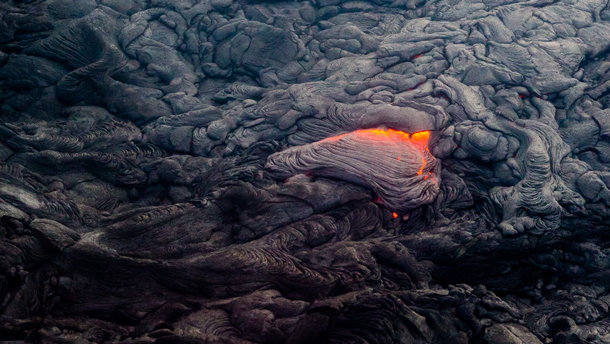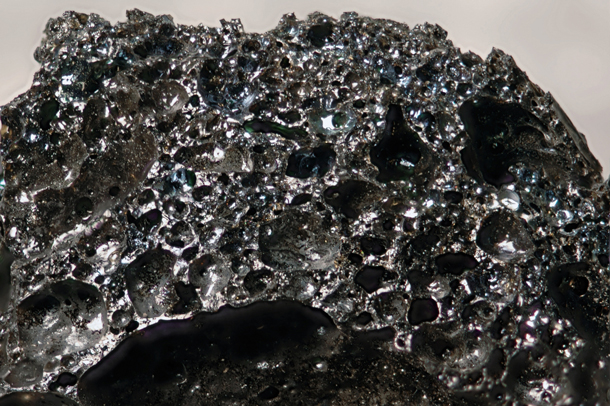Cool Fix for a Hot Planet: Storing CO2 in Rocks
Air Date: Week of May 18, 2018

Lava flows out from Hawaii’s Kilauea Volcano. When it cools, what was molten lava becomes hard, black basalt. (Photo: Sathish J, Flickr CC BY-NC-ND 2.0)
Scientists are studying how rocks might capture and store a greenhouse gas to help cool the planet. Solidified lava and magma could perhaps safely store carbon dioxide, through a chemical reaction that forms a stable solid carbonate from the climate-warming gas and the rock. Living on Earth’s Jenni Doering reports.
Transcript
CURWOOD: It’s Living on Earth, I’m Steve Curwood. Coming up, fighting for the wetland habitat of the tigers of Nepal, but first, this Cool Fix for a Hot Planet from Living on Earth’s Jenni Doering.
[MUSIC: COOL FIX THEME]
[SOUNDS OF LAVA]
DOERING: The snap, crackle, pop of hot lava flowing from Hawaii’s Kilauea Volcano is a reminder that the ground beneath our feet is very much alive. And even lava that cooled long ago into black, bubbly basalt can jump into action to help fight one of humanity’s biggest challenges: rising levels of carbon dioxide.
Basalt has the chemical potential to help take up carbon, as does peridotite, a greenish-black rock formed when magma cools deep in Earth’s mantle. If you happen to have an August birthday, peridot, its glassy, olive green cousin, is your birthstone. Basalt and peridotite aren’t gemstones, but they show their special powers when they come into contact with carbon dioxide.
If the CO2 is dissolved in water, as in a fizzy soda –
[SOUNDS OF SODA CAN OPENING, FIZZING SFX]

Vesicles (the geological term for bubbles) in basalt from Hawaii’s Kilauea Volcano. (Photo: James St. John, Flickr CC BY 2.0)
-- the chemical reaction happens fast. Magnesium or calcium ions in the rock lock up the carbon dioxide as a solid carbonate, like chalk, or the Tums or Alka-Seltzer you might pop in your mouth after a rich meal. Earth scientist Juerg Matter led a pilot study that injected carbon dioxide deep into Iceland’s basalt, with promising results.
MATTER: So if you go to the scientific literature, if you look at laboratory experimental data, and if you look at what the perception of scientists was, how fast mineralization occurs – it takes, you know, hundreds of years to thousands of years. And what we showed in this project was that within less than 2 years, all our CO2 we injected was mineralized.
DOERING: That project is now expanding, with support from several European research institutes. How feasible this method of capturing and storing carbon is, and what it would cost, are still uncertain, but basalt is common. It covers large areas of India, the Pacific Northwest, and Iceland. In all, basalt covers more of the Earth’s surface than any other rock type on this third rock from the sun. So in a twist of fate, ancient hot lava might just help our world chill out.
[SOUNDS OF BUBBLING LAVA]
That’s this week’s Cool Fix for a Hot Planet. I’m Jenni Doering.
CURWOOD: And if you have an idea for a Cool Fix for our hot planet, please send it our way and we might put it on the air. Our email address is: comments@loe.org –
That’s comments@ loe dot org.
Links
The CarbFix project in Iceland
NYTimes Interactive: “How Oman’s Rocks Could Help Save the Planet”
Living on Earth wants to hear from you!
Living on Earth
62 Calef Highway, Suite 212
Lee, NH 03861
Telephone: 617-287-4121
E-mail: comments@loe.org
Newsletter [Click here]
Donate to Living on Earth!
Living on Earth is an independent media program and relies entirely on contributions from listeners and institutions supporting public service. Please donate now to preserve an independent environmental voice.
NewsletterLiving on Earth offers a weekly delivery of the show's rundown to your mailbox. Sign up for our newsletter today!
 Sailors For The Sea: Be the change you want to sea.
Sailors For The Sea: Be the change you want to sea.
 The Grantham Foundation for the Protection of the Environment: Committed to protecting and improving the health of the global environment.
The Grantham Foundation for the Protection of the Environment: Committed to protecting and improving the health of the global environment.
 Contribute to Living on Earth and receive, as our gift to you, an archival print of one of Mark Seth Lender's extraordinary wildlife photographs. Follow the link to see Mark's current collection of photographs.
Contribute to Living on Earth and receive, as our gift to you, an archival print of one of Mark Seth Lender's extraordinary wildlife photographs. Follow the link to see Mark's current collection of photographs.
 Buy a signed copy of Mark Seth Lender's book Smeagull the Seagull & support Living on Earth
Buy a signed copy of Mark Seth Lender's book Smeagull the Seagull & support Living on Earth

